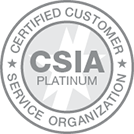The future of hybrid elements in non-profit event planning
Event management is a core element of running a non-profit association — and as with many other areas of association management, it has undergone a great deal of change over the past two years in order to adapt to the ever-shifting circumstances of the pandemic.
One significant adaptation associations made was moving to first fully virtual, then hybrid events. While all the way into early 2021, most associations were unable to plan any in-person events, there has over the past year been a slow reintroduction of face-to-face meetings. Organizations have approached this return in various ways, with some opting to remain virtual for now, others opting for fully in-person events, and still others opting for a hybrid approach.
It seems likely that many organizations will carry some of the meeting management approaches they developed during the pandemic into their meetings and events in the future, including the incorporation of certain aspects of hybrid events. However, the possibility of including hybrid elements in event planning was already on the table before the pandemic even began.
Drivers of Change Help Associations Think Ahead
Drivers of change identify trends that are poised to affect a given industry or area in the coming years. Research compiled by the American Society of Association Executives™ (ASAE) in 2017 as part of their ForesightWorks initiative shows that, for associations, hybrid events are one such driver of change, and their advent is a sure result of the many technological developments that have been making all sorts of long-distance communication increasingly easy to access, said Elizabeth Mauro, Senior Director of Client Services at Association Headquarters (AH).
“The ForesightWorks research identifies potential disruptors and opportunities, and in so doing, it helps facilitate conversations with association staff and volunteers around particular trends,” said Mauro.
Considering the implications of drivers of change encourages associations to think ahead to the decisions they will face in the future. So while COVID pushed the timeline of using hybrid events up for many associations, the idea of using them wasn’t completely new — and some associations were fortunate to have already dipped their toes in to the hybrid concept.
Improving What Works
The members of the Wound, Ostomy, and Continence Nurses Society™ (WOCN) are specialists, and as a result, there are only a few of them at any given hospital or medical center. For many years, this limited how many members of the association were able to attend the annual meeting because the nurses at each hospital had to take turns staying behind to ensure their workplaces had sufficient coverage.
This need for access is why WOCN began putting on hybrid events in 2013, according to Brooke Passy, CMP, DES, Senior Meeting Manager at AH. But that doesn’t mean their hybrid events haven’t evolved over time.
“WOCN used to live-stream the top 12 sessions, whereas now in 2022, we’ll be live-streaming almost all of our sessions,” Passy said. “And previously, virtual attendees were flies on the wall, watching the events passively, but now, we’re focused on the full experience of both in-person and virtual attendees.”
Another reason some organizations prefer to maintain a hybrid aspect to their meetings is the access it provides to international attendees. For their 2022 meeting, WOCN will be partnering with the World Council of Enterostomal Therapists (WCET). “While domestically, we’re potentially back to normal travel, that’s not necessarily the case around the world,” Passy said.
There are additional accessibility-related reasons for continuing to provide some element of virtual content as well. While the pandemic is less severe at this time, it is still ongoing, and there are some people who still are not comfortable traveling. Of those who are comfortable, they may not be able to take the time off, whether because of the pandemic or due to other reasons. Many companies and government groups still have travel bans in place, for example.
Hybrid options can also enable people who would not otherwise be able to attend due to financial hardship or physical disabilities, because not only does technology make events more accessible by allowing for easy-to-use closed captioning, which enables deaf and hard of hearing people, as well non-English speakers, to participate; it also provides both certified meeting planners and sponsors with metrics to determine things like how many people attend different sessions, how long they stay in those sessions, and how often specific sessions are rewatched.
Events Now and in the Future
For some organizations, though, hybrid events simply don’t appeal, whether because their members prefer a fully in-person experience or because hybrid elements aren’t conducive to the activities that bring value to the event. In such cases, the foray into virtual and hybrid events served to affirm the specific benefits offered by in-person meetings, and the ability to return to them is a welcome opportunity. For other organizations, there may be a desire to include hybrid elements to their events, but there can be logistical hurdles to staging these elements.
One obstacle is the existing contracts groups have for their 2022 and 2023 meetings — if a contract is already in place that obligates a group to take a specific number of hotel rooms for a specific number of nights or to meet a food and beverage guarantee, an association will have less opportunity to reduce that obligation than they did early on in the pandemic. Another finance-related difficulty is the increased cost of expanded audio-visual services, which are required to support a virtual meeting platform, whether through live streaming or through recording content to be viewed after the event has concluded. There is also the difficulty of replicating the in-person experience of things like networking and visiting vendor booths in the exhibit hall to consider.
This is another area where considering ASAE’s drivers of change research can help guide organizations in planning an event that will make the most impact for their membership.
“These challenges provide new opportunities for discussion on reinvention of what may be an association’s primary revenue source,” said Mauro. “Reviewing the drivers of change provides a broader world view. This evidence-based research helps volunteer leaders identify immediate needs and do scenario planning for the future.”
The sudden shift to virtual meetings precipitated by the pandemic resulted in virtual and hybrid events being introduced earlier than ASAE had initially predicted, but organizations were still able to take advantage of them to improve their event offerings.
“We were asking our volunteer leaders to make difficult decisions, some with significant financial implications, when we had no idea what the next 3, 6, or 12 months would hold in terms of our ability to conduct in-person meetings,” Mauro said. “But utilizing the ForesightWorks research helped bring focus to the conversation, not just to react to pandemic conditions but to look at opportunities in the longer term and determine whether it was a new potential audience or an evaluation of current educational offerings.”
Some hybrid elements, at least, are bound to stick around. “I think post-pandemic there will be a new normal of recording educational content from events and making it available online,” Passy said. “We are still in a transitional period right now, but the accessibility of content is forever changed because of the pandemic.”
Mauro agreed, adding that while many associations may return to in-person-only annual conferences, the virtual event will remain important because of increased opportunities to expand niche meeting offerings and reduce travel costs for in-person board or committee meetings.




